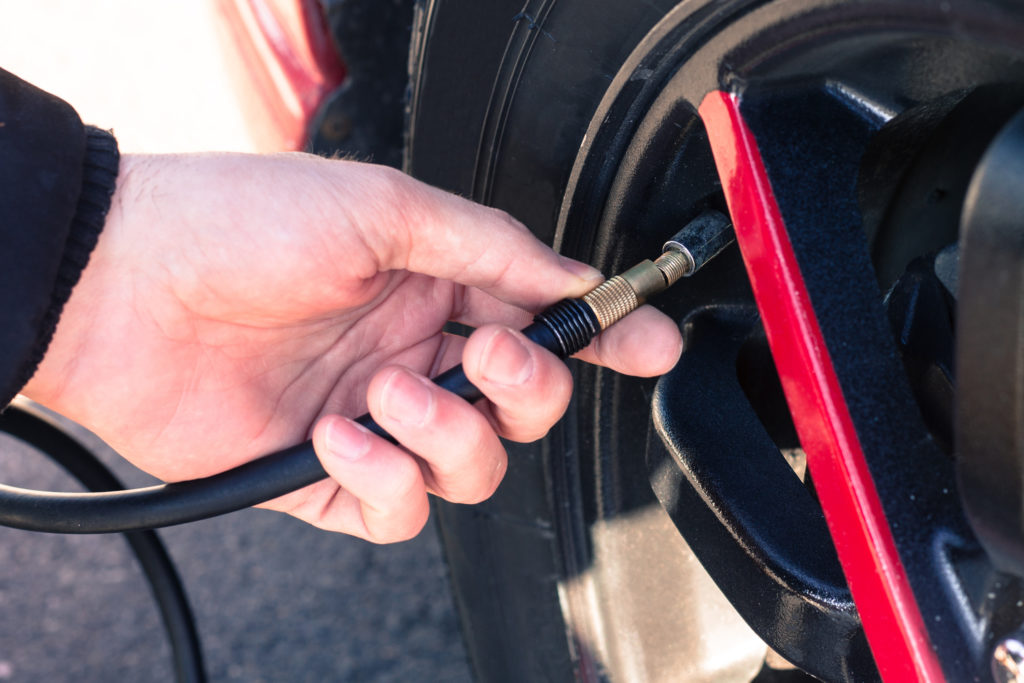We all know that routine maintenance is important for everything from our computers to our cars. But sometimes, we fall short. One of the most neglected routine car maintenance tasks is to check tire pressures and inflate them as necessary. That’s why newer cars have tire pressure warning lights, or tire pressure monitoring systems (TPMS), that let you know when you have under- or over-inflated tires (when any tire is 25% underinflated).
Older vehicles don’t have this useful warning light. So, don’t wait for a rupture to check or change a tire. Use this guide to learn how to check the pressure (PSI) of your vehicle tires and how to inflate them to the proper air level.
Why should you check your tire pressure?The number one reason why you should periodically check your tire pressure is SAFETY, but there are monetary and handling reasons as well:
Proper tire pressure (as recommended by the manufacturer) is needed to drive safely and efficiently. According to a 2009 report by the National Highway Traffic Safety Administration:
“…about 28% of light vehicles on our Nation’s roadways run with at least one underinflated tire. Only a few psi difference from vehicle manufacturer’s recommended tire inflation pressure can affect a vehicle’s handling and stopping distance. Poor tire maintenance can increase incidences of blowouts and tread separations. Similarly, underinflation negatively affects fuel economy.”
When your tires are underinflated, the tires get fatter, increasing their surface area. This causes high heat generation and extra resistance that could result in higher fuel costs, blown out tires, tire wear, and loss of control.
If you feel like you’re spending too much at the gas pump, it might be your tires. According to the US Department of Energy:
“You can improve your gas mileage by 0.6% on average—up to 3% in some cases—by keeping your tires inflated to the proper pressure.
Under-inflated tires can lower gas mileage by about 0.2% for every 1 psi drop in the average pressure of all tires.”
In addition to safety and fiscal concerns, keeping your tires properly inflated will also reduce your impact on the environment. When your tires are properly inflated, you’ll pay less for gas, replace your tires less often, and improve your handling and stopping distance. You’ll also feel better knowing that you are emitting less carbon dioxide and other harmful substances into the atmosphere.
What is the right PSI level?PSI stands for pounds per square inch. The recommended PSI for your vehicle’s tires is determined by the vehicle’s manufacturer and the recommended tire size.
One big question that we get is whether you should follow the recommended PSI level on the tire itself or the recommended PSI level printed in your owner’s manual or on the placard inside of door edge, glove box door, or fuel door.
Do NOT use the max PSI that is printed on the tire sidewall. This is not the recommended PSI level. The pressure amount on the tire is normally the maximum allowed pressure. The correct PSI level is almost always less than what you see printed on the side of the tire. Over-inflation can lead to poor handling and comfort, overheating and blow outs. Over 40 PSI is a dangerous level for most vehicles!
Make sure you always use the recommended PSI as provided in your owner’s manual and don’t go any more than 5 PSI over the recommended level. You should make sure, however, that your tires are appropriate for your vehicle. You can do this by checking the car’s owner’s manual or the placard that is on the inside of the driver-side door, glove box, or fuel door.
Most car tire pressure recommendations range from 30-35 PSI.
How often should I check tire pressure?A question in many minds is when is the appropriate time and frequency for checking and inflating vehicle tires.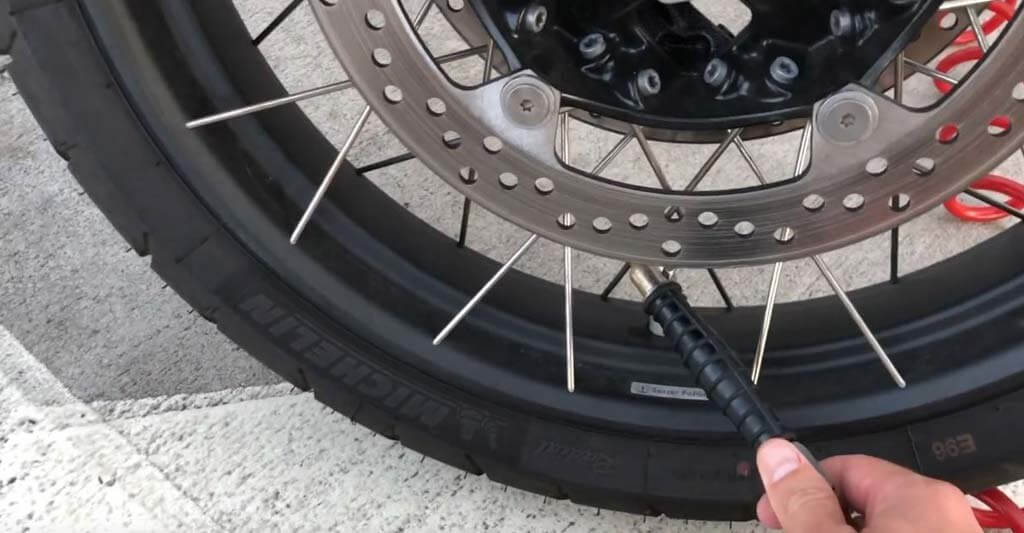
A quick google search will reveal a variety of different opinions and suggestions. Some say that you should check your tire pressure every 2nd visit to the gasoline station, while others say once every 3-6 months is OK.
Most tire and vehicle manufacturers, on the other hand, will say that you should check your tire pressure at least once every month, or every second trip to the gas pump. Your tires will lose around 1 PSI each for every month that goes by.
Unfortunately, not one answer will fit every situation. There are several factors that influence how often you should check your tire pressure, including:
Did you know that for every 10°-drop in temperature, you lose 1 pound of pressure?
If you have a leaky valve or a small puncture, you will lose air pressure much more quickly. This is one more reason why you should frequently check the tire pressure on all of your tires.
Since tire pressure constantly fluctuates, it’s important to check it periodically (at least once a month) and add air as necessary.
How to Check Tire PressureFinding out the tire pressure of your tires is incredibly easy. All you need is a pressure gauge (click here for additional items you should have in your vehicle).
Just make sure that you are checking your tires when they are relatively cold. If you check your tire pressure after a long drive, you will get an inaccurate reading since heat will temporarily increase the tire pressure reading.
Unfortunately, not all pressures gauges are created equal. Some are better than others. We recommend shelling out a couple extra bucks for a digital reader. The pop-up, stick-type versions are notoriously inconsistent and unreliable. A reliable gauge will be well worth the investment. Prices range from about $5 for the stick-type and about $30 for the digital and dial-type pressure gauges.
You can also check your tire pressure at most gas stations or auto repair shops. Discount Tire offers free tire pressure checks and inflation.
Here are the steps for checking your tire pressure: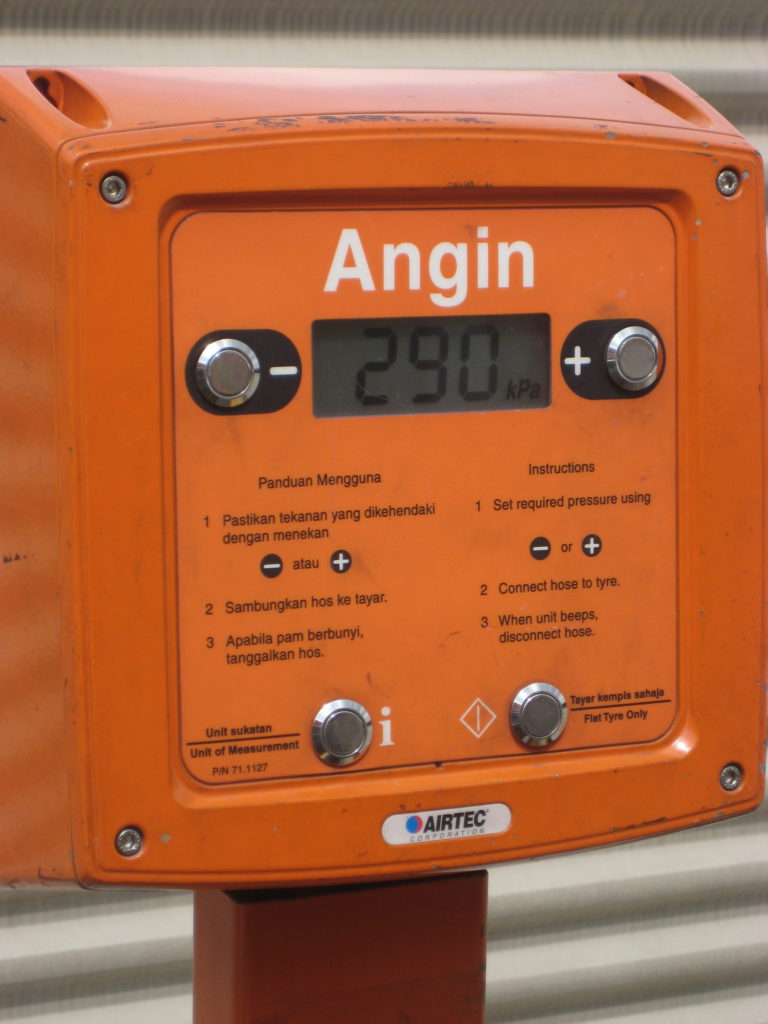 Check the tire pressure again. Release more air if necessary. If you release too much air, you can always add some air back.
Check the tire pressure again. Release more air if necessary. If you release too much air, you can always add some air back.It should only take you a couple minutes to check the air pressure of your vehicle’s tires. As soon as you restore tire pressure to the recommended levels, you’ll start experiencing the safety and savings that come with this regular maintenance task.
Watch this video for more information on how to check your tire pressure:
How to Inflate TiresHere are the steps for adding air to your tires:
 Instead, go to your local gas station that has a coin-operated air pump (ask the attendant if you can’t find it). You can also purchase your own automatic air compressor, but it will cost you around $50-$150.
Instead, go to your local gas station that has a coin-operated air pump (ask the attendant if you can’t find it). You can also purchase your own automatic air compressor, but it will cost you around $50-$150.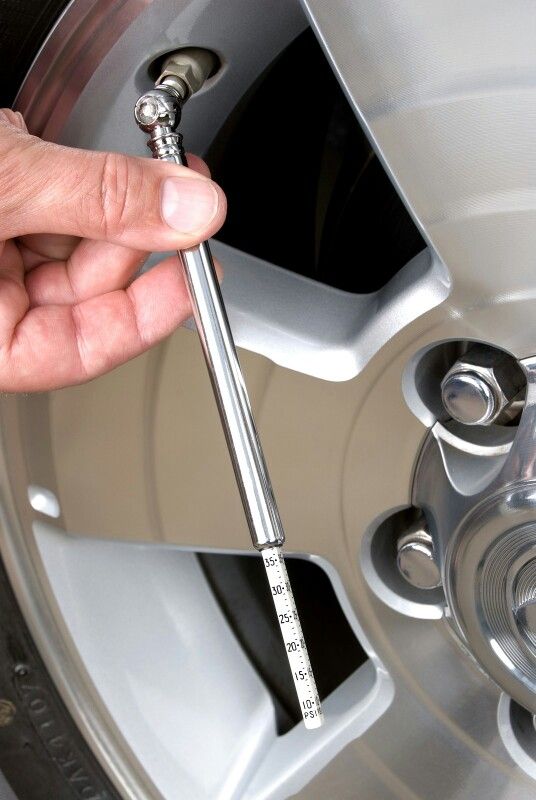 Hold it firmly against the valve as you listen to the air filling the tire.
Hold it firmly against the valve as you listen to the air filling the tire. You’ll want to screw them back on now.
You’ll want to screw them back on now.Remember, just one drop in PSI can lower your gas mileage by about 0.2%. For every 3-4 PSI units that your tire is underinflated, you are burning around 1% more fuel.
If your tires are flat, then you probably have a leak. Add air and see if you can drive around without the pressure dropping. If you hear air escaping the tire while you are filling up, then it’s time to replace the tire.
Tip: Learn how to use the air pump properly first. Some automatic air pumps at gas stations have a handle/switch that you need to depress in order for the air to flow. When you let go of the handle, a tire pressure gauge will pop out showing you the tire pressure. At the same time, air will be slowly released. If your air pump has this kind of handle, then you will want to hold down the handle for most of the time, periodically releasing it to check the pressure reading. Consult your own tire pressure gauge for accuracy.
When should I replace my tires?If you check your tire pressure at least once a month as recommended, you’ll also get a good idea of the general condition of your tires and when you should replace them.
We recommend using the penny test:
Source: bridgestonetire.com
Click here for more car maintenance tips. Click here for car winterization tips.
Auto Simple wants you to find a vehicle you love at a price you can afford. We carry a large selection of hand-picked, Certified Pre-Owned vehicles, all with a 6 month/6,000-mile Powertrain Warranty.
If you have any questions, don’t hesitate to speak with one of our Online Specialists or give us a call:
Chattanooga, TN – (423) 551-3600
Cleveland, TN – (423) 476-4600
Dayton, TN – (423) 775-4600
Dalton, GA – (706) 217-CARS (2277)
Follow us on social media for more useful information on buying, selling, and maintaining vehicles: Facebook, Twitter, Youtube, and Google+.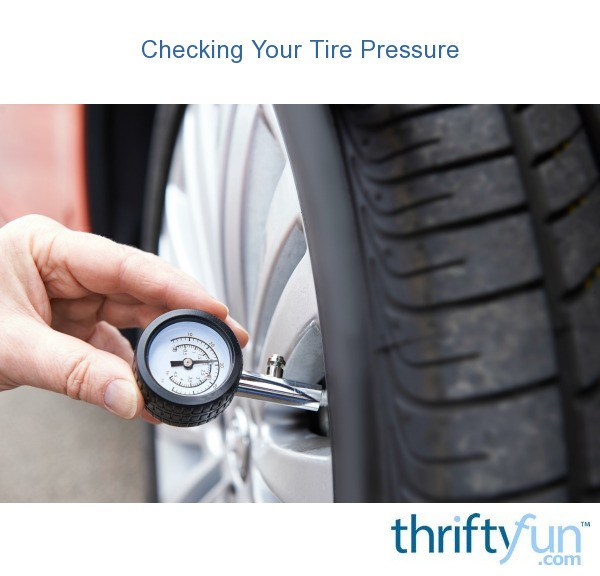
Picture this. You’re happily driving along a highway before your car starts wobbling, and as the vibrations get stronger, you wonder, what gives?
You pull into the next exit and check your tires of course, and lo and behold! One of your tires is looking a little miserable. You don’t have a flat, but it is clearly deflating.
Checking the PSI of your tires regularly should be part and parcel of your car’s regular maintenance, right up there with the oil levels. You can easily get a car tire pressure gauge from any auto shop, and sometimes they are even given out for free!
Fret not. If you happen to check your tires and realize that you are under the manufacturers’ recommended guidelines, head to your nearest gas station, and they’ll have a compressor that you can use, probably for a dollar or two. It is easier than you think.
If you have never inflated your car tires, here’s what to do.
Step 1
To begin, position your car near the air pump in such a way that the hose can reach all four tires.
Step 2
Find the right tire PSI for your car once you’ve parked in a decent spot. Look at the car manual, or a label containing this information that’s stuck to the driver’s door. If you don’t see a tire pressure label here, look inside the fuel door.
Tire pressure values from the owner’s manual.Step 3
Then remove each valve cap and don’t lose them! Put them in your pocket or something. There are countless poor tires around without valve caps, but you’ll have to deal with dirt, grime, and potential blockages.
Step 4
Connect each one of the valve stems to the air pump. Firmly secure the tube to the valve stem so that air cannot escape. A hissing sound, which indicates air is escaping from the tire, should not be heard while doing this. Start filling it with air.
Most of the compressors found at gas stations will have pressure gauges, or else, use any portal pencil gauge.
Step 5
Return the hose to the machine and replace the valve stem caps on your tires once you’ve filled all four tires to the proper pressure. Don’t forget to pay, if you have to! Some gas stations charge, but some are free.
Now you are all done and ready to go back down the road!
Watch this video to learn how to check and fill your car tires.When it comes to your vehicle, there are a lot of things that you need to take care of to keep it running smoothly. One of the most important aspects of car maintenance is making sure that your tires are properly inflated.
If your tire pressure is low, it can cause a variety of problems.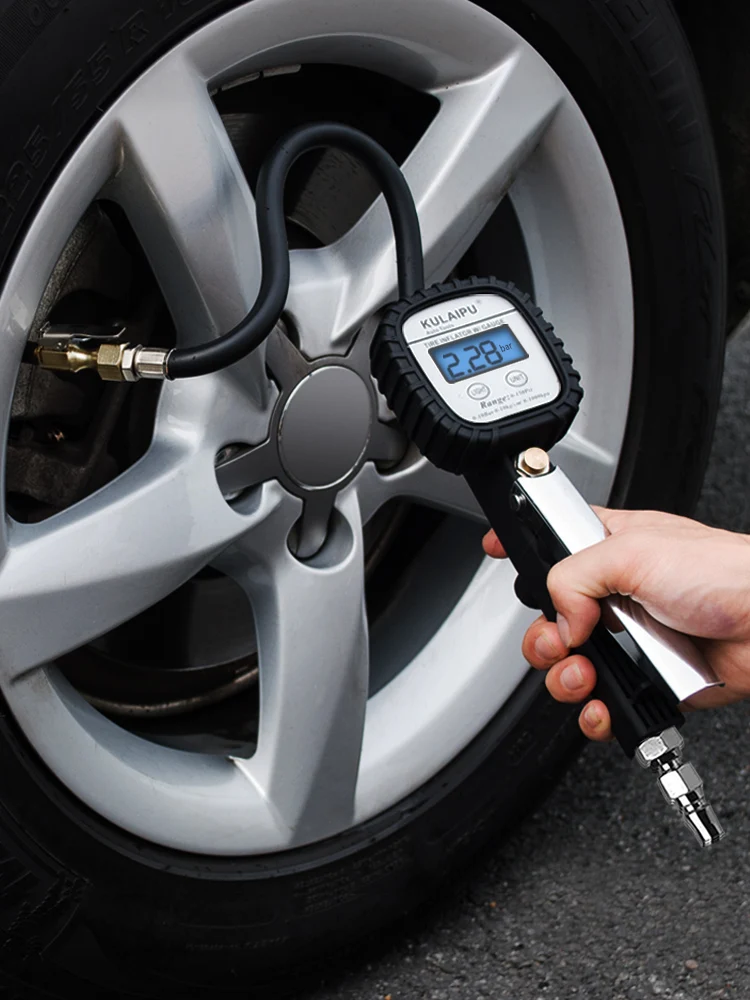 For one, it can lead to decreased fuel efficiency. Additionally, low tire pressure can cause uneven wear on your tires, which can shorten their lifespan.
For one, it can lead to decreased fuel efficiency. Additionally, low tire pressure can cause uneven wear on your tires, which can shorten their lifespan.
Worst of all, if your tire pressure is too low, it can make your car less stable and more prone to accidents.
You might think, well, why not just over-inflate, and be done with it?
When you drive on overinflated tires, you risk a range of problems. Over-inflated tires are more likely to blow out. A blown tire can cause you to lose control of your car, putting you and others on the road at risk.
In addition, several of your vehicle’s safety systems, such as your anti-lock brake system, are designed to operate when tires are filled to the manufacturer’s specifications. Some of your car’s driver assistance systems may be jeopardized if your tires are over-inflated.
Under-inflated tires lengthen braking distances greatly and have a significant impact on steering and handling.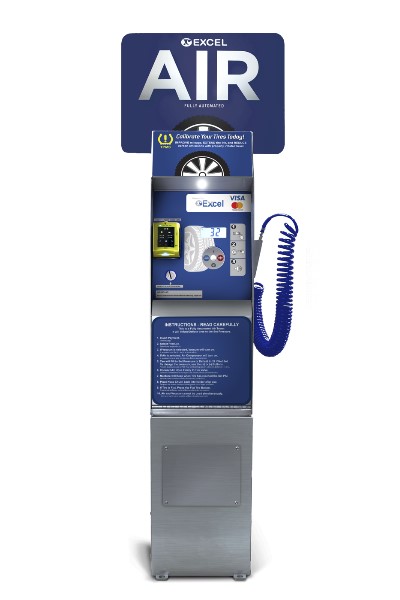 In addition, when tire pressure is low, more of the tread face of the tire contacts the road, causing friction.
In addition, when tire pressure is low, more of the tread face of the tire contacts the road, causing friction.
In severe circumstances, this friction can produce overheating, which can result in tread separation and blowouts. It could also cause the shortening of the life of your tires by 15% or more because the edges of your tires make increased contact with the road when they are under-inflated.
Improper tire pressure can cause quick or uneven wear, resulting in considerable internal tire damage, as well as unexpected tire failure and catastrophic injury.
To get the best out of your gas mileage, proper tire pressure should be adhered to according to the manufacturers’ instructions.
Related: How Long Should Your Tires Last & How To Make Them Last Longer?
Under-inflated tires force your engine to work harder, reducing fuel efficiency, and increasing the surface area with the road, resulting in higher resistance and greater wear and tear.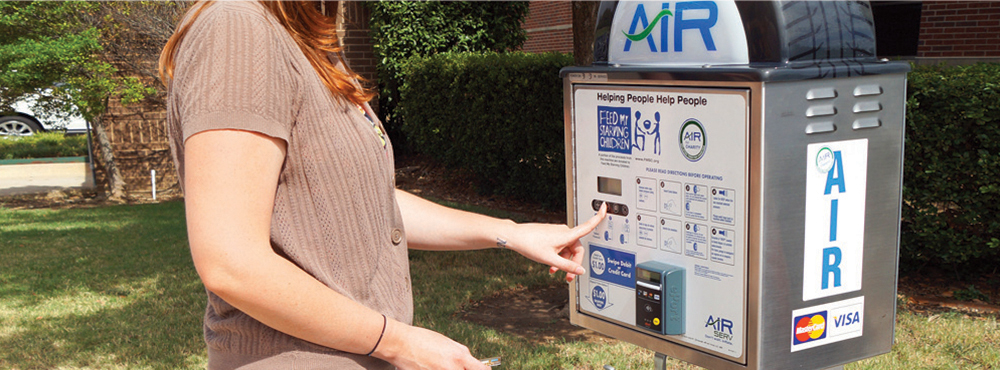
As a result, the gas economy suffers and gasoline costs rise – up to 1.3 cents per liter. Depending on how frequently you fill up, this may add up to hundreds of dollars in a single year.
Tire pressure should be checked monthly, or as often as you can, especially if you are hitting the road on a long drive. Your tires will continue to lose pressure even if there are no leaks. Oftentimes, tires lose an average 1 pound per square inch (PSI) of tire pressure every month.
Related: How to Use an Air Compressor to Inflate Your Tires at Home
Because your car is unlikely to warn you until your tire pressure is quite low, it’s critical to check your tires manually. Checking your tire pressure regularly will help extend the life of your tires and alert you to small concerns before they become major headaches.
When it’s hot outside, the air in your tires expands and takes up more volume, while when it’s freezing outside, the air takes up less space.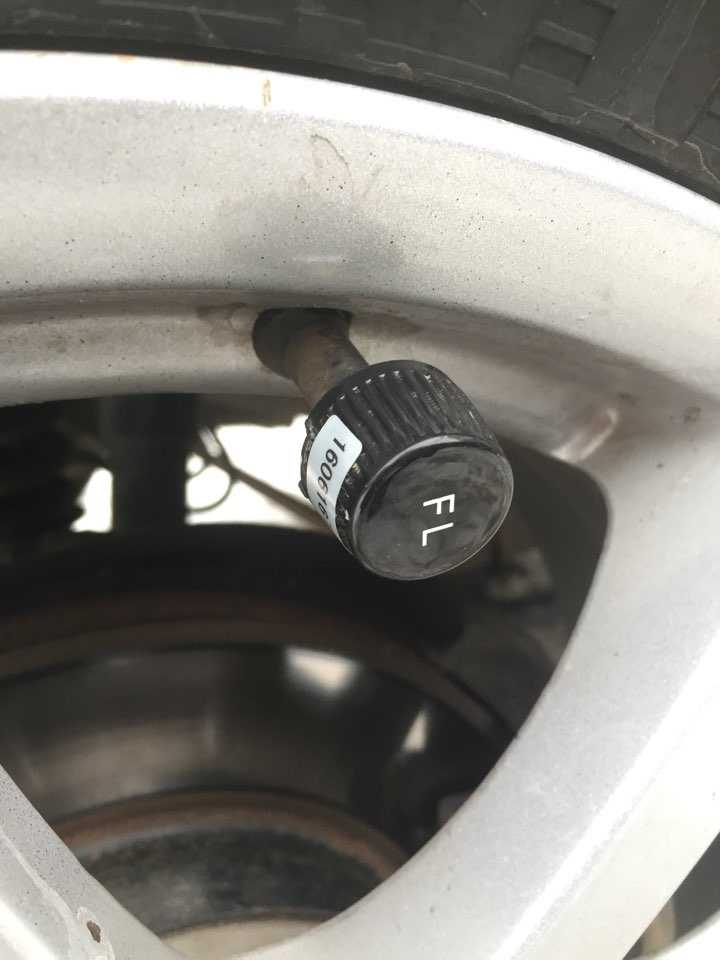 As a result, when the temperature drops, your car’s computer thinks your tires are deflated.
As a result, when the temperature drops, your car’s computer thinks your tires are deflated.
For every 10 degrees Fahrenheit that the temperature decreases, the inflation pressure in tires drops by 1 to 2 pounds per square inch (PSI).
In addition, while you drive your car and the tires heat up, the pressure in the tires will increase by one psi every five minutes for the first 15 to 20 minutes. The temperature difference can range from 3-5 pounds per square inch (PSI).
Do not wait until the TPMS (Tire Pressure Monitoring System) light illuminates before checking the tire pressure, since a regular TPMS may:
Tire manufacturers offer a suggested PSI that specifies the ideal pressure level for your vehicle’s tires. That PSI value is for when your tires are cool.
That PSI value is for when your tires are cool.
When adding air to your tires in the winter, it’s best to do it when the tires are still cool.
Measure the tire pressure in each tire before leaving the house and make a note of it. Measure the tires again when you get to the gas station, then add the amount of pressure you need based on the initial measurement.
If you drive with your tires under-inflated, you will lose some steering control, increase friction, cause additional tire wear, and reduce your car’s gas mileage efficiency.
Similarly, as the season and weather change from hot to cold, you’ll be able to make a variety of modifications to your vehicle. One thing to keep in mind is that your tires may require air inflation again. This is due to the fact that when the temperature drops, so does the air pressure in the tires.
In addition, tire pressure can even change throughout the day! What is hot during the day can be sub-zero at night, depending on your geographical location.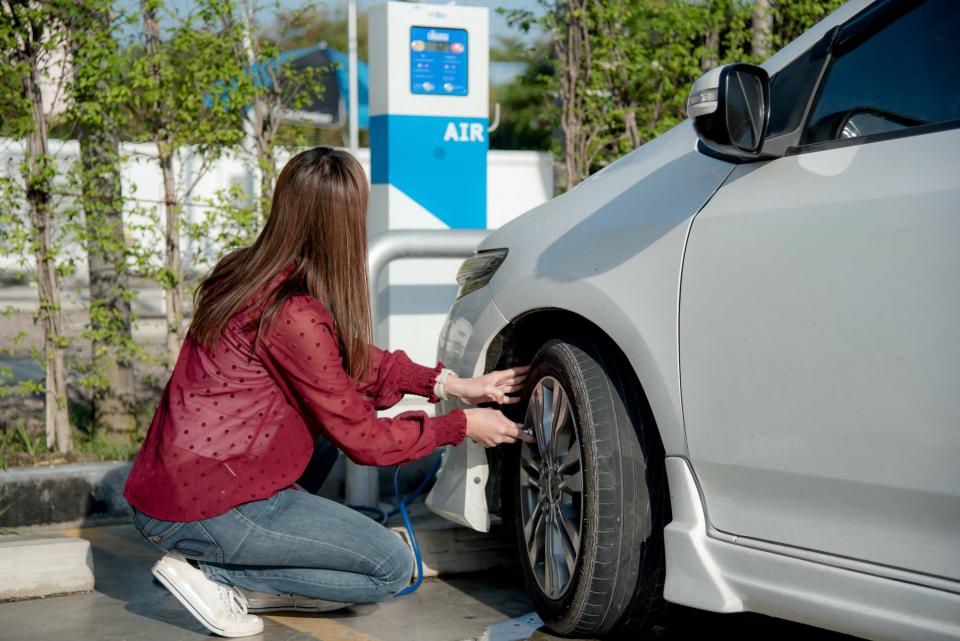
So there you have it. It’s pretty easy. Check your tires from time to time, make sure that the pressure falls within the recommended manufacturer’s guidelines, and fill it with air if it falls below.
Avoid over-inflating your tires, as this can lead to numerous problems and safety concerns!
Stay safe out there and happy driving!
Maintaining the correct air pressure in your vehicle's tires not only increases your safety on the road, but also increases your vehicle's mileage. The correct air pressure for a tire is written on the side of the tire and listed as pounds per square inch (PSI). Once you have found this number, you can take the car to check the tire pressure at the gas station.
Contents
Head to the gas station where there is an air tire filling machine. They are usually located outside and look like little boxes with long black hoses attached to them (sometimes labeled as "air"). Drive the car to the car so that the car is in the center of your car. This way the air hose will definitely reach all of your tires.
They are usually located outside and look like little boxes with long black hoses attached to them (sometimes labeled as "air"). Drive the car to the car so that the car is in the center of your car. This way the air hose will definitely reach all of your tires.
Choose one tire to start with and look for the PSI label on the tire. It will be written on the side of the tire: look for the numbers or letters of the brand of the tire and at the end of this label, usually in brackets. For example, the tire side might read: PR300345 All Weather (30-45 psi). This tire requires between 30-45 PSI for safe operation.
Remove the tire air core cover. The air stem is the black stem that will protrude through your screw cap rim.
Attach the air hose to the tire. Most air hoses have a trigger at the end. The tip comes to the end of the air rod. Firmly press the tip against the stem for two seconds and the built-in pressure gauge at the top of the trigger assembly will extend the pressure readout bar. Remove the air hose end from the air stem. If the air hose does not have a trigger assembly, purchase a tire sensor from a gas station or auto parts store. Slide the tip of the pressure gauge onto the stem and the pressure bar will slide back. Remove the sensor.
Remove the air hose end from the air stem. If the air hose does not have a trigger assembly, purchase a tire sensor from a gas station or auto parts store. Slide the tip of the pressure gauge onto the stem and the pressure bar will slide back. Remove the sensor.
Read the pressure bar to see the current PSI level in your tire. The pressure bar is marked with a series of lines and numbers. Most pressure bars use lines to indicate two pounds of pressure between integers. For example, at the very end of the bar there will be four lines, and then the number 10; then four more lines and the number 20, etc. The point at which the pressure bar stopped extending from the body indicates the number you should read to determine the PSI level in your tire.
If necessary, add air by pushing the tip of the air hose onto the air stem while holding the trigger. Wait a few seconds, release the trigger and remove the air hose. Check tire pressure again. Make sure you hit the pressure bar before starting the process or your readings will be inaccurate. Repeat until you have the correct PSI level in your tire.
Repeat until you have the correct PSI level in your tire.
TIRES-TOP
Most network filling stations, such as TNK, Gazpromneft, Podsolnukh, Sell and others, have opened a new free service - tire inflation. This is a very interesting marketing ploy that helps drivers keep track of their tire pressures while their family members visit the market. For many car owners, using a public compressor has become the norm. And some drivers have not yet encountered such a service and do not know how to pump up a tire at a gas station and what nuances should be paid special attention to.
This is a very interesting marketing ploy that helps drivers keep track of their tire pressures while their family members visit the market. For many car owners, using a public compressor has become the norm. And some drivers have not yet encountered such a service and do not know how to pump up a tire at a gas station and what nuances should be paid special attention to.
The tire inflation device is integrated into the gas station building from the end or into an auxiliary building. It looks like a payphone. The box is equipped with several control buttons, a pressure gauge, mechanical or digital. The stages of using the service look like this:

Since little air is lost when the fitting is disconnected, it is recommended to set the pressure setting to a slightly higher value. For example, you need 2.2 bar, but it is more correct to set 2.3 bar.
Some gas stations are equipped with non-automatic compressors. That is, you are offered a tire inflation gun with a pressure gauge. Connect the fitting to the valve and pull the trigger. As soon as the arrow of the sensor points to the required number, stop air injection, turn off the gun and return it to its place.
Nuances.